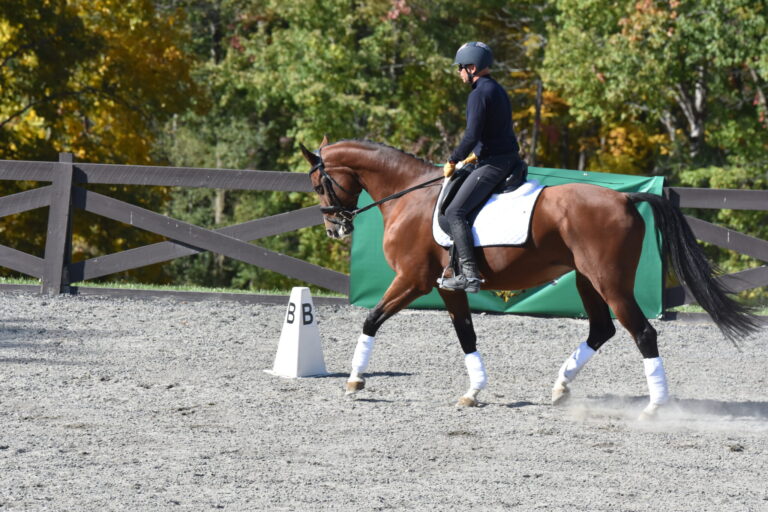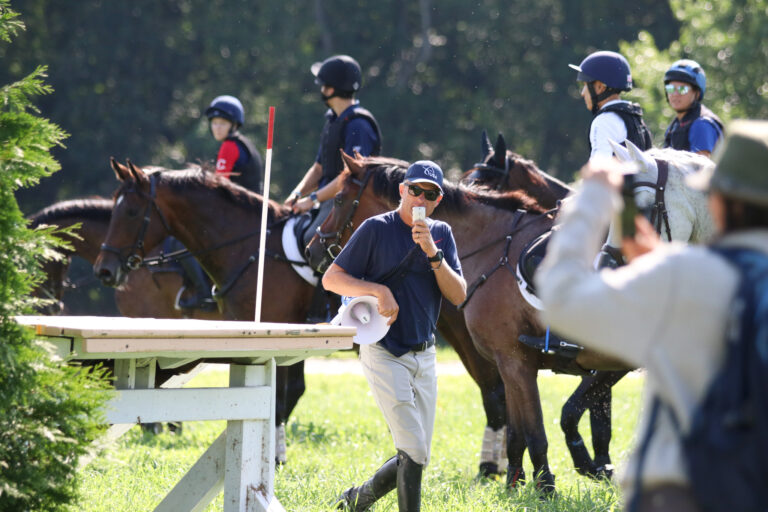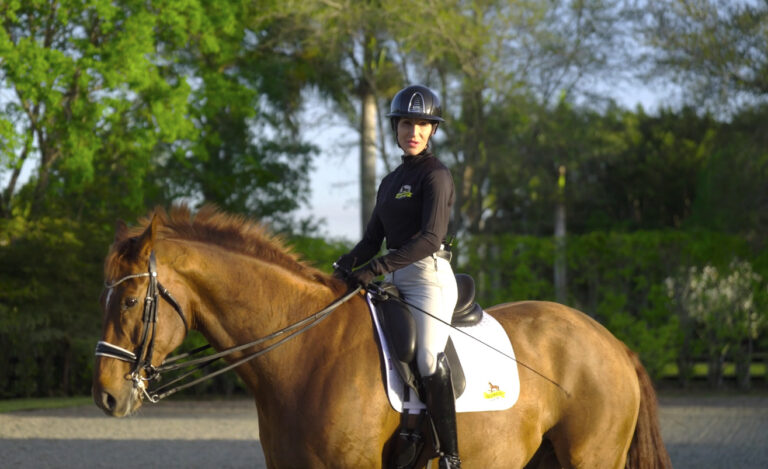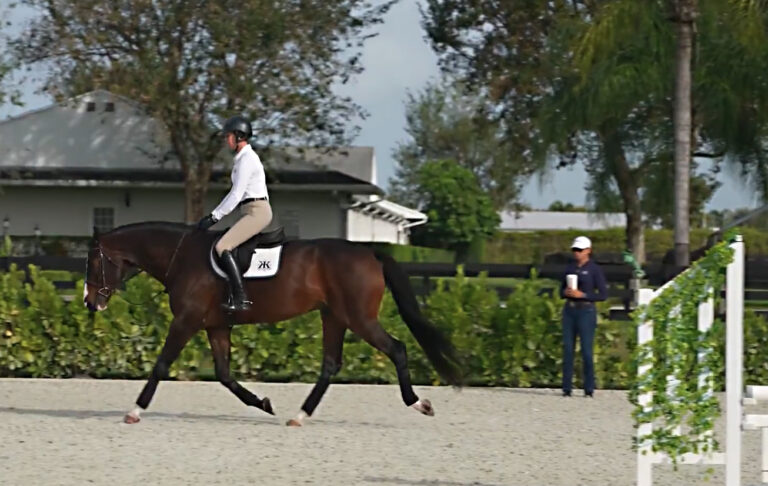We ride and compete because for us there is nothing better in the world than the horse/rider connection. Yet we know it’s not always perfect. I teach many clinics for riders of all levels, and I often need to help students who are passionate about riding but whose enjoyment of their horses is compromised by a lack of confidence.
I don’t have a magic formula for building rider confidence, but I have something almost as good: tools a student can use to address just about any issue she is having with her horse. My starting point is that in the competitive partnership that is your relationship with your horse, there needs to be a leader and that leader must be you. Think about it. You’re the only one in the partnership who knows the plan—where you’re going and what you’re doing. You’re the only one who knows whether you’re turning right or left in the dressage ring, when the water jump is coming up on cross country or which show-jumping fence in the ring is next on course.
So you have to be the leader. What’s more, your horse likes having you in charge. A timid horse could need anything from detailed instructions to encouragement whereas a confident or aggressive type might do better with a minimal amount of suggestion and direction. In any case, the key to communicating with your horse, figuring out what he needs and letting him know what you want—in other words, making yourself the leader—is always the same: education and repetition.

From the Ground Up
Let’s start at the beginning. Riders who have confidence issues tend to want to focus on problems they’re having when they’re actually in the saddle, but I encourage you to first think in terms of more basic skills. Suppose your horse won’t stand when you mount. That’s intimidating for some riders and can be a real inconvenience or sometimes a question of safety. The truth we tend to overlook is that all of these basic horsemanship skills are related. It’s always about attention to detail. In my experience with some of the best riders in the world, their horses stand when they get on. Why? Because the riders pay attention to this skill. Their horses lead correctly because the riders pay attention to it. They pay as much attention to ground work as they do to work under saddle because they know it’s all part of the whole of good horsemanship and good riding.
Of course, we know it’s not unusual for a very good rider to go along for years casually allowing her horse to walk away as she’s mounting, until something helps her realize, “This may be related to the fact that my canter lead changes are always a little late.” Again, the behavior is all related in your horse’s mind. It’s all a matter of does he know what you want and does he do it when you ask him?
If this simple but important detail is an issue for you and your horse, your trainer can probably suggest an exercise for teaching him to stand or direct you to a ground-work program. If you can teach your dog to sit, you can teach your horse to stand.
From the Ground Up: Establishing Correct Mounting


The Basics in Motion
To continue building that sense of communication and confidence once you’re on your horse, have a plan before you put your foot in the stirrup. The plan gives you something to focus on instead of nerves, and it reinforces your role as the leader in the partnership because you start right out by giving your horse something to do.
Does that sound complicated? It is not. Your plan once you’re mounted and ready is to march off in a positive four-beat walk. We’re back to the classical Training Scale here, the basis for everything: It starts with rhythm, which creates relaxation. Rhythm is probably the single biggest skill I teach and that I pay attention to when I ride. If you get on feeling nervous and tense, it’s hard to have rhythm because you’re not allowing your horse to walk and move out, and then he will get tense. If you’re having difficulty creating the four-beat walk rhythm with your body, think one–two–three–four in time with your horse’s steps. If that doesn’t work, count aloud. That’s what I ask my students to do when they’re having trouble establishing a steady walk rhythm. When you say it and hear it, your body responds to it.
There are times when your horse shouldn’t start at the walk, for instance, because he’s too cold, too tight or too nervous. In that case it’s better to trot, but again you need to have a plan as the leader. I tell my students, “Give your horse something to do before he gives you something to do.” Instead of just trotting around, focus on something: serpentines on a loose rein, inside leg to outside rein, suppling one side of his body and then the other until he relaxes into the rhythm and begins to seek the connection with your hand. Now you’re not worrying about your own nerves; you’re using a simple tool to communicate with your horse.
It’s not unusual for riders accustomed to working in an enclosed area to lose some confidence when outside the ring. Riding out in a field is no different from riding anywhere else: You need to know you can go where you want to at the speed you wish. Time for a plan! Decide before you ever leave the barn how you will keep your horse and yourself busy outside the ring with simple schooling figures and upward and downward transitions. You can use this strategy to maintain leadership throughout all of your flatwork.
The Basics in Motion: Marching Off


The Basics in Motion: Ride a Figure Eight




Canter a Pole and Halt




Now Over Fences
Building confidence in jumping is no different than strengthening your confidence about riding in general. Assuming your horse already knows how to jump, does he go exactly where you want him to go in the ring or out in the schooling field and does he go at the speed you want?
If I have a student whose confidence over small, simple fences is really weak, I don’t hesitate to go all the way back to rails on the ground. If you lack confidence, it’s usually because you feel you don’t have control. How do you stop when you want to stop? Go when you want to go? Turn right? Turn left? Everything—including the Training Scale, straightness and rhythm—is some version of that. You have to know that you have control to feel confident over fences. You can do anything with rails on the ground. Trot one and halt. Canter one and halt. Trot or canter through a series of them. Make a figure eight or an entire course. With this work you’re re-establishing your driving and restraining aids and the aids for going right and left on a daily basis. With repetition you can fine-tune it so that when you think something, your horse does it.
In my clinics, we often have horses who land over a jump and speed up. This can be a confidence issue for a rider who is already a little tentative about jumping. There is a simple tool I use to help students. Speeding up after a fence is actually a loss of rhythm. I tell students to make a downward transition to trot immediately after the jump, then pick up the canter again only when the horse relaxes into a rhythm. If you have this plan in mind from the outset, it increases your confidence. It really works. And if you repeat the downward transition enough times, I guarantee that eventually your horse will jump the fence and then slow down.
It’s interesting to me that some riders are reluctant to use this tool, almost as if they think it means they’re somehow not as good as they should be. In fact, I have a favorite story about it. Years ago, a good friend (who is also one of my owners) signed us up for a clinic with Greg Best, two-time Olympic individual show-jumping silver medalist. My friend is a fairly novice rider and I am an FEI-level professional. We ended up in a group where we were jumping about 2 feet. I was riding a Prelim horse I was very proud of, but he was a strong horse, and that day I could not make him do what I wanted. He kept speeding up after the jumps, and finally Greg said, “Your problem is that you can’t maintain your rhythm. I think you should do a trot transition when you land. Stay on course, do a trot transition, then pick up the canter again.” It was so simple and so effective. And my friend was so tickled!
Over Fences: Fix Rushing After a Jump





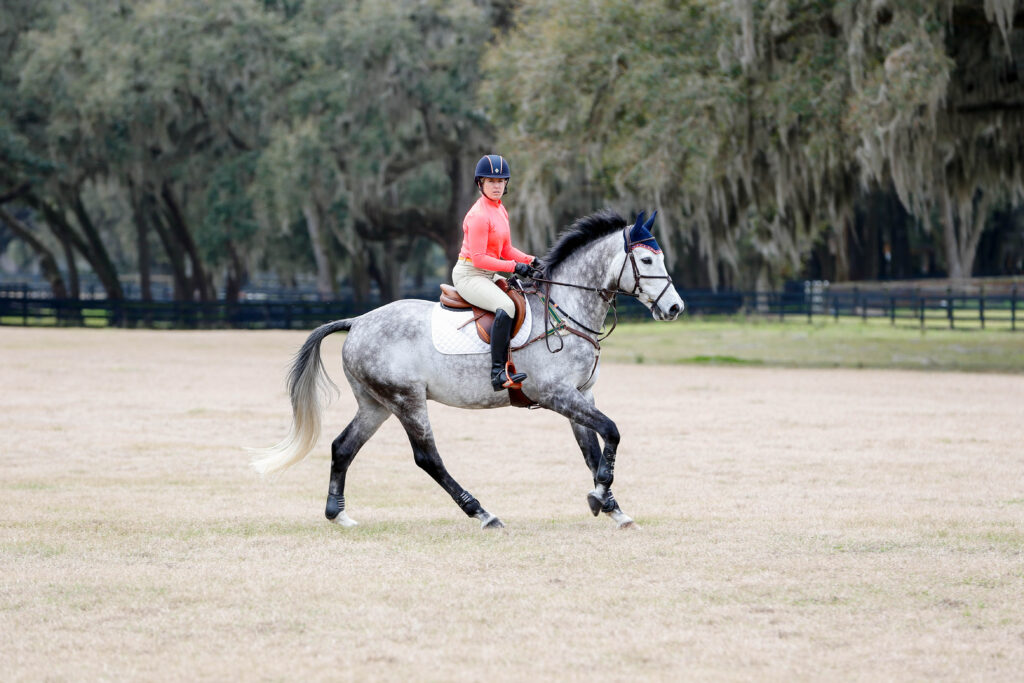
Don’t Hurry
The final word on becoming your horse’s leader is something Canadian Olympic show jumper Ian Millar told me: Never be in a hurry with your horse. He will learn better and more consistently if you do not feel pressed for time. If you have only 15 minutes to spend with your horse, you can get a lot done in that time (for instance, valuable ground work)—but before you put on his halter, you need to decide exactly what it is you want to do.
All of the tools I’ve explained will work if you’re willing to repeat them until your horse realizes what you want. The basics of good horsemanship and good riding are not a magic formula that top riders keep to themselves. Those basics are the same as they’ve been. Building your confidence is a matter of being willing to find out the basics and to repeat them many times.
When you become your horse’s leader, repetition is also the key for coping with normal anxiety about challenges like riding a cross-country course. Let’s face it, eventing is a fear-inducing sport and part of its lure is overcoming that fear. After you’ve done it over and over, your fear is more about performance anxiety (“I hope I don’t mess up at Fence 6”) than actual terror. As part of this process, you need to not be in a hurry about moving up the levels. A good leader takes care of those she is leading. Before you move up, your current level of competition should feel easy for you and your horse. If your horse is confident and you’ve done all the basics I’ve talked about, you’re probably ready.
‘You Can Do This’
“As the rider who is a student, you want to be learning with someone who makes you feel like you can do this, whatever the challenge of the moment is,” says Sharon White. The teaching/training program at her Last Frontier Farm in Summit Point, West Virginia, is just such a source of encouragement and confidence. Her students’ appreciation is obvious to anyone who has ever experienced the wave of cheers from orange-clad supporters who follow Sharon around the cross-country course.
Sharon’s career has been shaped by some of the greats in equestrian sport. Early on, she rode with eventing legends Bruce Davidson and Torrance Watkins. A consistent influence has been international star Jim Wofford, who continues to be a sounding board for her riding and her overall career. “She is an unusual package,” Jim says. “She’s a super rider and horsewoman and a wonderful instructor. Unlike many elite riders, she tells her students what they need to do to get better—not what Sharon would do.” FEI ‘O’ judge and Grand Prix dressage rider Linda Zang comes to coach at Sharon’s farm regularly.
About Sharon White
Sharon White is an international CCI5* three-day eventing rider, trainer and Level 4 U.S. Eventing Association ECP Certified Instructor based at Last Frontier Farm in Summit Point, West Virginia. White’s career includes over 10 starts at the Kentucky Three-Day Event with five different horses. She has also traveled overseas to contest CCI5* events at Lühmuhlen (France) and Les Etoiles de Pau (France) as well as CCI4* events at Boekelo (Netherlands) and Hartpury (United Kingdom). She most recently earned a team silver medal at the 2023 Pan American Games with Claus 63.
This article originally appeared in the May 2015 issue of Practical Horseman.





